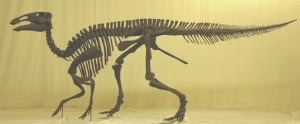Saturday, June 21, 2014
DINOSAURS IN ROCK ART? – THE HAVASUPAI CANYON HADROSAUR:
Havasupai Canyon panel. Picture
from www.6000years.org.
One of the first, and still most popular, examples of
dinosaurs in rock art that creationists and young-earthers point to is the
Havasupai Canyon hadrosaur (duck-billed
dinosaur). Creationists are driven to prove the position that the bible says
the earth is only 6,000 years old based upon 17th century Bishop
Usher’s calculation that “the first day of creation began at nightfall
preceding Sunday, October 23, 4004 BC” (Wikipedia).
This dinosaur petroglyph was discovered by Samuel Hubbard, Curator of Archaeology of the Oakland Museum, in the late 1800s. Hubbard led an expedition to the Havasupai Canyon area of the Grand Canyon. “On two occasions in the late 1800s,
Samuel Hubbard, Curator of Archaeology of the Oakland Museum, visited an area
of the Grand Canyon known as the Havasupai Canyon. As an evolutionist, he was
amazed to find a petroglyph (carved rock drawing) of an elephant made by Native
Americans. But another depiction was “cut into the sandstone much more deeply
than the elephant.” Its height was 11.2 inches, with a neck approximately 5.1
inches in length and a tail of 9.1 inches. What kind of animal is it? Dr.
Hubbard believed that he had found an ancient drawing of a dinosaur.” http://www.genesispark.com/exhibits/evidence/historical/ancient/dinosaur/)
Charles R. Knight painting of a hadrosaur.
Photograph from www.muttpop.fr.
I first heard of this one many years ago. When I was young
these creatures were often pictured as standing upright on the tripod formed by
their legs and tail, pretty much as this petroglyph shows. Recently, of course,
paleontologists have rethought those old assumptions and now know that these
creatures held their body and tail much more horizontally. What this means is
that, where some time back this image seemed to make some sense, we now know
that this is totally incorrect. That brands this either as an error of
identification, or a hoax. Indeed some researchers now point to the shape of
the head and suggest it might be a poorly drawn bird, but, of course, then the
tail makes no sense at all.
Grand Canyon hadrosaur petroglyph showing the
supposed "bullet hole" at the base of the tail.
Photograph from www.bible.ca.
“An example of Native American rock art carved into the
walls of Grand Canyon. It was discovered in 1879 by E. L. Doheny and documented
in 1924 by a scientific expedition which included Dr. Charles W. Gilmore, Curator
of Vertebrate Paleontology, United States National Museum. The resulting
publication reported as "fact" that "some prehistoric man made a
pictograph of a dinosaur on the walls of this canyon..." Doheny
Scientific Expedition, p.5. Recently someone used it as a target practice
and you can see a bullet hole at the base of the tail. It shows just how old
the etchings must be since the fresh bullet mark cuts through the thick
"rock varnish". (www.bible.ca)
Now I have to question the “bullet
hole” alluded to above. It shows in the photo as a white disk with not internal
textural detail or shading visible and no sign of the color of the base rock.
Even if a real hole had been heavily chalked to make it stand out it would show
differences of light and shadow with the brightest side facing the direction of
the sun and shadowing on the side facing away from the sun. This leads me to suspect
that the “bullet hole” was created in Photoshop
or Microsoft Paint and is not real.
Notice in the photo of the petroglyph with the illustration by Paul Taylor (below) there is no bullet hole.
Havasupai Canyon petroglyph and a rendering by Paul Taylor of
how the model would have been standing were it an authentic
picture of a hadrosaur. www.paleo.cc/ce/dino-art.htm.
That brings us to the pair of pictures by Paul Taylor. He
shows a photo of the petroglyph on the left and a painting of his
interpretation of the actual animal on the right, and he has concluded that it
is an Edmontosaurus. This is explained
as follows: “For example, in his creationism-promoting
book The Great Dinosaur Mystery,
which is aimed at young readers, Paul Taylor shows a petroglyph from Havasupai
Canyon in Arizona. He highlights the petroglyph with a white outline, shown
alongside a painting labeled "Edmontosaurus" (a type of two-legged
Hadrosaur dinosaur). As depicted by Taylor, the two profiles look virtually
identical. To an unsuspecting reader (especially a child) this might be
impressive, and foster the conclusion artist must have seen such a dinosaur.”
As I said above, fifty years ago
this would seem to have made sense because our picture of all dinosaurs
(including hadrosaurs) was quite
different. Compare the illustrations above with the illustration of the hadrosaur from Wikipedia, and look at
the reconstructed skeleton. Indeed, had it really been made by a Native
American who co-existed with dinosaurs and could see them in person, he would have known that the tail should stick out
straight and portrayed it that way. This in itself brands this petroglyph as a
modern hoax. Either that, or it is meant to be
something else and was done so poorly that it is totally unrecognizable. Either
way, it certainly is not a hadrosaur
dinosaur.
REFERENCES:
www. 6000years.org
Wikipedia
Subscribe to:
Post Comments (Atom)










No comments:
Post a Comment